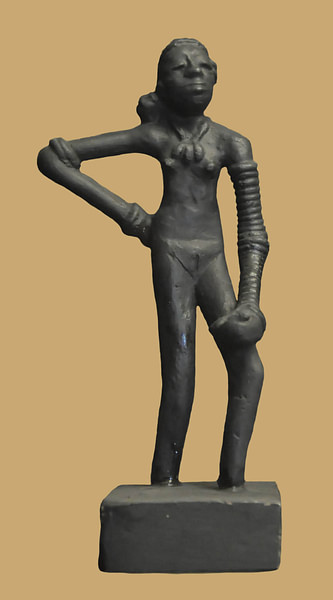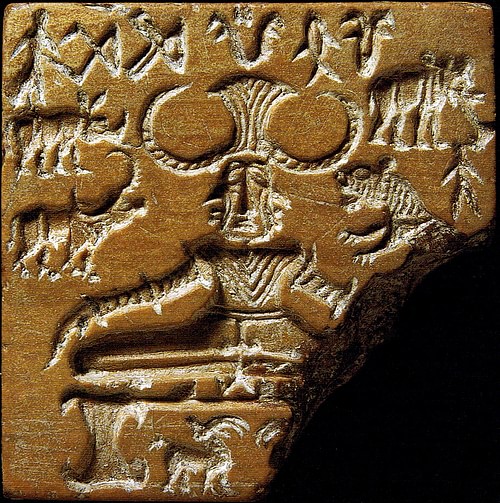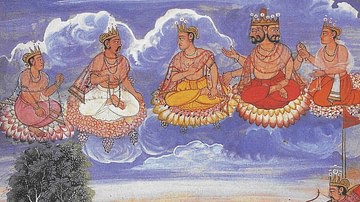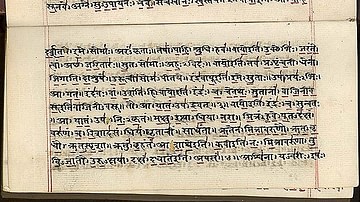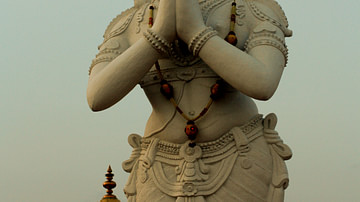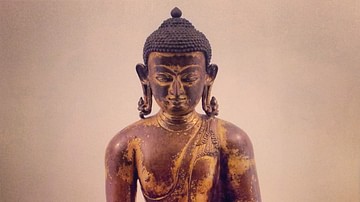For well over 1,000 years, sacred stories and heroic epics have made up the mythology of Hinduism. Nothing in these complex yet colourful legends is fixed and firm. Pulsing with creation, destruction, love, and war, it shifts and changes. Most myths occur in several different versions, and many characters have multiple roles, identities, and histories. This seeming confusion reflects the richness of a mythology that has expanded and taken on new meanings over the centuries.
Hinduism stood for a wide variety of related religious traditions native to India. Historically, it involved the evolution since the pre-Christian epoch. In turn, it looked back to age-old belief of the Indus Valley Civilization followed by the Vedic religion.
Indus Valley Civilization
The Indus Valley Civilization ensued during the Bronze Age (3300–1300 BCE; mature period 2600–1900 BCE). It mostly spread along the Indus and the Punjab region, extending into the Ghaggar-Hakra river valley and the Ganga-Yamuna Doab, surrounding most of what is now Pakistan, the western states of modern-day India, as well as extending into south-eastern Afghanistan, and the easternmost part of Baluchistan, Iran.

The geography of the Indus Valley put the civilizations that arose there in a similar situation to those in Egypt and Peru, with rich agricultural lands being surrounded by highlands, desert, and ocean. Of late, Indus sites had been discovered in Pakistan's north-western Frontier Province as well. Other smaller isolated colonies were found as far away as Turkmenistan. Coastal settlements extended from Sutkagan Dor in Western Baluchistan to Lothal in Gujarat. An Indus Valley site was located on the Oxus River at Shortughai in northern Afghanistan,
By 2600 BCE, early communities turned into large urban centres. Such inner-city centres included Harappa, Ganeriwala, Mohenjo-daro in Pakistan, and Dholavira, Kalibangan, Rakhigarhi, Rupar, and Lothal in India. In total, over 1,052 cities and settlements have been found, mainly in the region of the Indus and the tributaries.
Steatite seals had images of animals, people (perhaps gods), and other types of inscriptions, including the yet un-deciphered writing system of the Indus Valley Civilization. A number of gold, terra-cotta and stone figurines of girls in dancing poses showed the presence of some dance form. Also, these terra-cotta figurines included cows, bears, monkeys, and dogs. Sir John Marshall reacted with surprise when he saw the famous Indus bronze statuette of a slender-limbed dancing girl in Mohenjo-daro:
When I first saw I found it difficult to believe that they were prehistoric; they seemed to completely upset all established ideas about early art, and culture. Modelling such as this was unknown in the ancient world up to the Hellenistic age of Greece, and I thought, therefore, that some mistake must surely have been made; that these figures had found their way into levels some 3000 years older than those to which they properly belonged.
Now, in these statuettes, it was just this anatomical truth which was so startling; that made us wonder whether, in this all-important matter, Greek artistry could possibly have been anticipated by the sculptors of a far-off age on the banks of the Indus.
It was widely suggested that the Harappan people worshipped a Mother goddess symbolizing fertility. A few Indus valley seals displayed swastika sign which were there in many religions, especially in Indian religions such as Hinduism, Buddhism and Jainism. The earliest evidence for elements of Hinduism is before and during the early Harappan period. Phallic symbols close to the Hindu Shiva lingam was located in the Harappan ruins.
Shiva
One famous seal displayed a figure seated in a posture reminiscent of the lotus position, surrounded by animals. It came to be labelled after Pashupati (lord of beasts), an epithet of Shiva. The discoverer of the Shiva seal (M420), Sir John Marshall and others have claimed that this figure is a prototype of Shiva, and have described it as having three faces, seated on a throne in a version of the cross-legged lotus posture of Hatha Yoga. Yogi's penis is erect, with both testicles prominently visible. The precise placement of both heels under the scrotum is an advanced Tantric Yoga technique known as Bandha, meaning knot or lock. It is normally used to sublimate and redirect sexual energy and can endow the practitioner with spiritual powers.
A large tiger rears upwards by the yogi's right side, facing him. This is the largest animal on the seal, shown as if warmly connected to the yogi; the stripes on the tiger's body, also in groups of five, highlight the connection. Three other smaller animals are depicted on the Shiva seal. It is most likely that all the animals on this seal are totemic or heraldic symbols, indicating tribes, people or geographic areas. On the Shiva seal, the tiger, being the largest, represents the yogi's people, and most likely symbolizes the Himalayan region. The elephant probably represents central and eastern India, the bull or buffalo south India and the rhinoceros the regions west of the Indus river. Heinrich Zimmer agrees that the Pashupati figure shows a figure in a yoga posture.
Pashupati
The people of the Indus Valley also appear to have worshipped a male god. The most important depiction of an imagined Hinduism god is seal number 420. Many other seals have been found depicting the same figure, but not in the same detail as number 420. The deity is wearing a headdress that has horns, the shape being reminiscent of the crescent moon that modern image of Siva shows on his forehead.
What are thought to be linga stones have been dug up. Linga stones in modern Hinduism are used to represent the erect male phallus or the male reproductive power of the god Siva. But again, these stones could be something entirely different from objects of religious worship. Even today, Siva is worshipped in both human form and that of the phallus. The deity sitting in a yoga-like position suggests that yoga may have been a legacy of the very first great culture that occupied India.
Religious Sign of Swastika
The earliest sure use of swastika motifs in the archaeological record goes to the Neolithic epoch. The symbol appears in the "Vinca script" of Neolithic Europe (Balkans, 6th to 5th millennium BCE. Another early attestation is on a pottery bowl found at Samarra, dated to as early as 4000 BCE. Joseph Campbell in an essay on The Neolithic-Palaeolithic Contrast cites an ornament on a Late Palaeolithic (10,000 BCE) mammoth ivory bird figurine found near Kiev as the only known occurrence of such a symbol predating the Neolithic. The swastika appears only very rarely in the archaeology of ancient Mesopotamia.
In Hinduism, the Swastika in two drawings symbolizes two forms of the creator god Brahma. Facing right it signifies the evolution of the universe; facing left it typifies the involution of the universe. The swastika is one of the 108 symbols of the Hindu deity Vishnu and represents the Sun's rays, upon which life depends. It is also seen as pointing in all four directions (north, east, south and west) and thus implies stability. Its use as a Sun symbol can first be seen in its image of the god Surya. The swastika is used in all Hindu yantras and religious designs.
Buddhism originated in the fifth century BCE and spread throughout the Indian subcontinent in the third century BCE. The swastika symbol (right-hand) was believed to have been stamped on Gautama Buddha's chest by his initiates after his death. It is known as The Heart's Seal. With the spread of Buddhism, the Buddhist swastika reached Tibet and China. The symbol was also introduced to Balinese Hinduism by Hindu kings.
Well over 400 distinct Indus symbols, some say 600, have been found on seals, small tablets, or ceramic pots and over a dozen other materials, including a signboard that apparently once hung over the gate of an inner citadel.
A large number of eminent scholars argue that the Indus system did not encode language, but was instead similar to a variety of non-linguistic sign systems used extensively in the Near East and other societies. Others have claimed on occasion that the symbols were exclusively used for economic transactions, but this claim leaves unexplained the appearance of Indus symbols on many ritual objects, many of which were mass-produced in moulds. No parallels to these mass-produced inscriptions are known in any other early ancient civilizations.
Mohenjo-daro
Mohenjo-daro or “heap of the dead” was the largest city excavated of the Indus Valley or Harappan Civilization. Mohenjo-daro was a Sindhi word in the locality meaning 'mound of the dead'.
The scholars Parpola and Asfaq identified another seal (M 430) found at Mohenjo-daro as the one relating to a unique ritual of equinox. It was a stellar ceremony marking the equinox at the star constellation of Krittika - Alcyon. The legend on the seal cited: the epoch (Kali Yuga – the present epoch we live in) set off at the beginning of the sign of the goat on Wednesday at sunrise at Lanka.
To cut short a fascinating tale of astral importance with religious nuance, it was the city of Lanka which had the place of honour as the prime meridian passed through it in 3102 BCE.
One more narration in this regard was in the travel record of Hwen Tsang in 630-635 CE. He saw a palisade (stupa) of Mauryan times. It was one hundred feet high. Cunningham said of this pillar:
The principality of Middle Sind, which is generally known as Vichalo or 'Midland' is described by Hwen Tsang as only 2,500 li or 417 miles in circuit. The chief city, named 'O-fan-cha' was at 700 li or 117 miles from the capital of the upper Sind, and 50 miles from Pitasala, the capital of lower Sind. As the former was Alor, and the latter was almost certainly the Pattale of the Greeks or Haiderabad, the recorded distances fix the position of O-fan-cha in the immediate neighbourhood vicinity of the ruins of an ancient city called Bambhra-ka-Thul or simply Bambhar. This, according to tradition, was the site of the once famous city of Brahmanwas or Brahmanabad […].
The city can be located because the circumstances are narrated in detail. The king of the city had previously submitted, but the citizens withheld their allegiance, and shut their gates. By a stratagem, they were induced to come out, and a conflict ensued, in which Ptolemy was seriously wounded in the shoulder by a poisoned sword. The mention of Ptolemy's wound enables us to identify this city with that of Hermetalia, which Diodorus describes as the 'last town of the Brahmins on the river.
Hermes in Greek is the muted term for Brahma. The Chinese syllable fan is the well-known phrasing of Brahma. Hence, both O-fan-cha and Hermetalia is a direct wording of Bambhra-ka-thul or Brahma-sthal. From all these discussions, it seemed certain that what Hwen Tsang visited was the city of Mohenjo-daro and its real name was Brahma-sthal or Brahmanabad. The meaning of the name Mohenjo-daro is 'Heap of the Dead'. Such a name seems peculiar for a prosperous city like this.
The Hindi word was mohan jodad.o. This word jodad.o had cognates in many mleccha, meluhha languages. The Sindhi word d.a_r.o meant 'feast given to relatives in honour of the dead'. A number of scholars made out that meluhha was the Sumerian name for mleccha, meaning non-Vedic, barbarian. It was used by the Aryans much as the ancient Greeks used barbaros, indicating garbled speech of foreigners or native people of the country.
The city flourished between 2600 BCE and 1900 BCE, although the first signs of settlement in the area had been dated to the period of 3500 BCE. Excavation at this level was impossible due to the high water table that made even simple excavations of Mohenjo-daro difficult. The city covered around 200 hectares of land and at its height might have had a population of 85, 000 people. The site was located in the modern Larkana district of Sind province in Pakistan. Mohenjo-daro was the largest city in the southern portion of the Indus Valley Civilization and important for trade and governance of this area.
The Great Mound, or Citadel, stood out the west end of Mohenjo-daro. The mound rose 40 feet about the plain at present time; it would have been higher at the time Mohenjo-daro was inhabited. There was a gap between the mound and the lower city. Because of the large size and separation from the rest of the city, it was thought the mound might have been used for a religious or administrative purpose. This hypothesis was supported by the architecture found on the top of the mound. The mound at Mohenjo-Daro had two distinct features: the Great Bath and the Granary or Meeting hall. The Great Bath was a sunken tank on the top of the mound; the tank was 12 meters long, 7 meters wide and was sunk 2.4 meters below the depth of the mud bricks that enclosed it. The Great Bath was one of the first aspects of Indus Valley life that could be related to modern Hinduism. The Great Bath might also be linked to the concept of river worship, much like the worship of the River Ganga today.
Emergence of the Mitanni Kingdom
In northern Mesopotamia, a great power arose: the Mitanni kingdom. Whatever we could gather about it is from indirect sources. Those people were called Kharri. Some philologists believed that this term was the same as Arya. According to the Vedic Index of Names and Subjects, compiled by Macdonald and Keith, this was the normal designation in Vedic literature from the Rig-Veda onwards of an Aryan of the three upper classes. The Mitannian invasion of northern Mesopotamia and the Aryan influx into India represented two streams of wandering migrations from a common cultural axis.
In 1906-07 CE at Boghaz Keui (about eighty miles to the south east of Ankara, modern capital of Turkey) Hugo Winckler discovered the great state archive of the Hittite Empire containing more than 10,000 cuneiform tablets written in Akkadian cuneiform. One tablet recorded a peace treaty concluded in about 1400 BCE between the Hittite Monarch Suppiluliumas and Mattiuaza, King of the Mitanni. Four gods were called upon as witness to this treaty in the records: In-da-ra, Uru-w-na, Mi-it-ra and Na-sa-at-ti-ia. These names were nearly identical with the Vedic gods Indra, Varuna, Mitra and Nasatya. According to the eminent Indologist Paul Thieme, during the time of the Boghaz Keui treaty, these gods were brought into Iranian mythology. The Avestan scholars affirmed that many Vedic gods were revived, though they were below the supreme god Ahura Mazda. The Mitannians of the upper Euphrates River worshipped them around this epoch.
When Vedic texts were the oldest surviving evidence of early Indo-European-speaking peoples, it was assumed that these texts preserved aspects of Proto-Indo-European culture with careful accuracy. Many ethnologists hoped to unify Indo-Iranian, Celtic, Norse, Greek and Roman into a Proto-Indo-European religion. Max Muller believed that Indo-Iranian religion began as sun worship. G. Dumézil stressed the tripartite social system of Indo-European religion and society. Later scholarship had moved away from considering all these religions near-identical. Instead, since early in the 20th century CE, following Meillet, Thieme and Kuiper, the social function of the Indo-Iranian Asura/Āditya deities was stressed; they were an innovative group not found in Indo-European religion.
Several scholars held that Indo-Aryans reached Assyria in the west and the Punjab in the east before 1500 BCE. The Hurrite speaking Mitanni rulers, influenced by Indo-Aryan, turned up from 1500 BCE in northern Mesopotamia, and the Gandhara grave culture emerged from 1600 BCE. Shaffer & Lichtenstein (in Erdosy 1995:139) stated that:
This shift by Harappan and, perhaps, other Indus Valley cultural mosaic groups, is the only archaeologically documented west-to-east movement of human populations in South Asia before the first half of the first millennium BC.
This could have been caused by ecological factors, such as the drying-up of the Ghaggar-Hakra River and increased aridity in Rajasthan and other places. The Indus River also began to flow east and flooding occurred.
Iron Age Vedic religion
The religion of the Vedic period (also known as Vedism or Vedic Brahmanism or, in a context of Indian antiquity, simply Brahmanism was a historical predecessor of Hinduism. Many scholars insisted that to call this period Vedic Hinduism was a contradiction in terms since Vedic religion was very different from what we generally called Hindu religion - at least as much as Old Hebrew religion was from medieval and modern Christian religion. However, Vedic religion was treatable as a predecessor of Hinduism.
According to traditional views, the hymns of the Rig-Veda and other Vedic hymns were divinely revealed to the rishis, who were considered to be seers or "hearers" (shruti meant "what was heard") of the Veda, rather than "authors". In addition, the Vedas were said to be "apaurashaya", a Sanskrit word meaning uncreated by man and which further revealed their eternal non-changing status.
Elements of Vedic religion reached back to a Proto-Indo-Iranian religion and an earlier Proto-Indo-European religion. The Vedic period was held to have ended around 500 BCE, Vedic religion with time evolving into the various schools of Hinduism. Vedic religion also influenced Buddhism and Jainism.
Proto-Indo-Iranian religion meant the religion of the Indo-Iranian peoples prior to the earliest Vedic (Indo-Aryan) and Zoroastrian (Iranic) scriptures. These shared a common inheritance of concepts including the universal force *rta (Vedic rta, Avestan asha), the sacred plant and drink *sauma (Vedic Soma, Avestan Haoma) and gods of social order such as *mitra (Vedic Mitra, Avestan and Old Persian Mithra, Miϑra), *bhaga (Vedic Bhaga, Avestan and Old Persian Baga). Proto-Indo-Iranian religion was an archaic offshoot of Indo-European religion.
The documented history of Indian religions began with historical Vedic religion, the religious practices of the early Indo-Aryans, which were collected and later redacted into the Samhitas, four canonical collections of hymns or mantras composed in archaic Sanskrit. These texts were the central shruti (revealed) texts of Hinduism. The period of the composition, redaction and commentary of these texts was known as the Vedic period, which lasted from roughly 1500 to 500 BCE.
The late Vedic period (9th to 6th centuries BCE) marked the beginning of the Upanisadic or Vedantic period. This period heralded the beginning of much of what became classical Hinduism, with the composition of the Upanishads, later the Sanskrit epics, still later followed by the Puranas.
The Sanskrit word véda "knowledge, wisdom" was derived from the root vid- "to know". This was reconstructed as being derived from the Proto-Indo-European root *u̯eid-, meaning "see" or "know".
The Rig-Veda was counted among the four canonical sacred texts (śruti) of Hinduism known as the Vedas. Some of its verses are still recited as Hindu prayers, at religious functions and other occasions, putting these among the world's oldest religious texts in continued use. The Rig-Veda was full of several mythological and poetical accounts of the origin of the world, hymns praising the gods, and ancient prayers for life, prosperity, etc.
It is one of the oldest extant texts in any Indo-European language. Philological and linguistic evidence implies that the Rig-Veda was composed in the north-western region of India, roughly between 1700–1100 BCE (the early Vedic period). There were strong linguistic and cultural similarities with the early Iranian Avesta, deriving from the Proto-Indo-Iranian times.
The text is organized in 10 books, known as Mandalas, of varying age and length. The "family books": mandalas 2-7, were the oldest part of the Rig-Veda and the shortest books; they were arranged by length. Tradition linked a rishi (the composer) with each hymn of the Rig-Veda. In all, 10 families of rishis accounted for more than 95% of the hymns. The compilation by each family went on over a long period of time. Thus, the Rig-Veda was not one book compiled and put together by the sages: each mandala stood out on its own.
The Rig-Vedic hymns were dedicated to various deities, chief of whom being Indra, a heroic god praised for having slain his enemy Vrtra; Agni, the sacrificial fire; and Soma, the sacred potion or the plant it was made from. Equally prominent gods were the Adityas or Asura gods Mitra–Varuna and Ushas (the dawn). Also invoked were Savitr, Vishnu, Rudra, Pushan, Brihaspati or Brahmanaspati, as well as deified natural phenomena such as Dyaus Pita (the shining sky, Father Heaven ), Prithivi (the earth, Mother Earth), Surya (the sun god), Vayu or Vata (the wind), Apas (the waters), Parjanya (the thunder and rain), Vac (the word), many rivers (notably the Sapta Sindhu – the seven rivers starting with the Indus, and the Sarasvati River). The Adityas, Vasus, Rudras, Sadhyas, Ashvins, Maruts, Rbhus, and the Vishvadevas ("all-gods") as well as the "thirty-three gods" were the groups of deities mentioned.
The priests performed the solemn rituals for the noblemen (Kshsatriya) and some wealthy merchants (Vaishyas). They prayed for abundance of children, rain, cattle (wealth), long life and an afterlife in the heavenly world of the ancestors. This mode of worship had been preserved even now in Hinduism, which needed recitations from the Vedas by a purohita (priest).
The religious practices rested on a priest administering rites that often involved sacrifices. Homa (also known as homam or havan) was a Sanskrit word which referred to any ritual in which making offerings into a consecrated fire was the primary action. At present, the words homa/homam and havan were interchangeable with the word Yagna. Although a consecrated fire was the central element of every homa ritual, the procedure and items offered to the fire varied by what was the occasion of the ceremony, or by the benefit expected from the ritual. Procedures invariably involved
- the kindling and consecration of the sacrificial fire;
- the invocation of one or more divinities; and,
- making of offerings (whether real or visualized) to them with the fire as via media, amid the recitation of prescribed prayers(mantras).
The sacred fire formed the focus of devotion; it was often held on certain types of dung, wood, dried coconut and so on. The fire-altar (vedi or homa/havan kunda) was generally made of brick or stone or a copper vessel, and was almost always built especially for the occasion, being taken apart immediately afterwards. This fire-altar was always built in square shape. While very large vedis were seldom built for major public homas, the usual altar would be as small as 1 x 1 foot square and rarely exceeded 3 x 3 feet square.
In all events, the arrangement was in the middle of a space, which could be either outdoors or indoors. The principal people performing the ceremony and the priests who instructed them through the rituals seated themselves around the altar, while family, friends and other devotees formed a larger ring around that centre.
The Vedas
- Rig Veda
- Sama Veda
- Yajur Veda
- Atharva Veda
Of these, the first three were the principal original division, also called "trayī vidyā", implying "the triple sacred science" of reciting hymns (RV), chanting (SV) and performing sacrifices (YV).
The Sama-Veda Samhita (from sāman, the term for a melody applied to metrical hymn or song of praise) consisted of 1549 stanzas, taken almost entirely (except for 78 stanzas) from the Rig-Veda.
The Yajur-Veda Samhita had archaic prose mantras and also in part of verses borrowed and adapted from the Rig-Veda. Its purpose was practical, in that each mantra must accompany an action in sacrifice but, unlike the Sama-Veda, it was compiled to apply to all sacrificial rites,
In the Vedic literature, the Veda was one – the Rig-Veda. It was not the Vedas as the foreign scholars cited quite often. From the narration about the composition of the Sama-Veda, it was the chanting of the hymns, taken almost entirely from the Rig-Veda. The Yajur-Veda contained the details of the platform to be made, dedicated to the deity in whose homage the homa was going to be recited. For every deity there were separate chanting and separate platform for the ritual of yagna. The prose hymns here were again taken from the Rig-Veda.
The Atharva-Veda embodied an independent parallel tradition to that of the Rig-Veda and Yajur-Veda. It added in much of early traditions of healing and magic that had parallel in other Indo-European literature.
The Atharva-Veda was less common than other Vedas as it was little used in solemn ritual. Its first part composed chiefly of spells and incantations, concerned with protection against demons and disaster, spells for the healing of diseases, for long life and for various desires or aims in life. The largely silent Brahman priest looked at the procedures of the ritual and mended it with two mantras and pouring of ghee when a mistake occurred. An early text, its status had been ambiguous due to its magical character.
